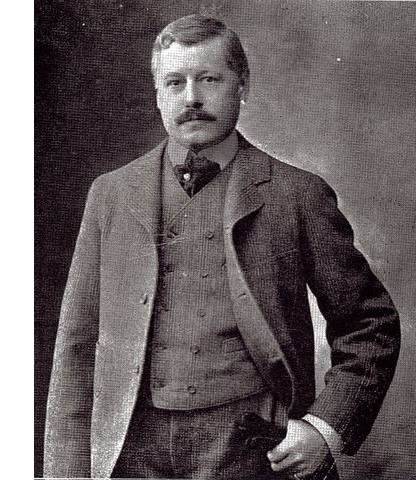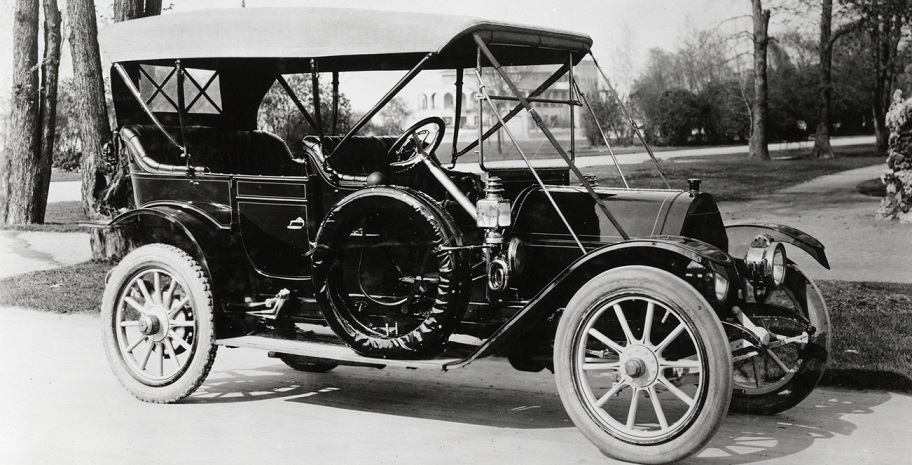The Carhartt was an automobile manufactured in Detroit, Michigan, by the Carhartt Automobile Company from 1911–12.
The company claimed that "28 years of manufacturing success culminates in the Carhartt car," but this was based on the company's expertise in manufacturing overalls.
Two 4-cylinder models were advertised - the Junior 25hp and Four 35hp, with the latter having six different body styles, all priced at $2250. In 1912 a 50hp Four was offered, priced from $2500 to $3500. Very few of these cars were built before Carhartt returned exclusively to the manufacturing of clothing.
The Carhartt Automobile Corporation
By Matt Wolfe
 Founded by Hamilton Carhartt (pictured right) in Detroit, Carhartt Inc. has been making durable work apparel since 1889. Carhartt became the clothing brand of choice for numerous railroad workers during the turn of the century, and the company’s apparel later became a common uniform for construction workers, farmers, and numerous other blue collar trades. What isn’t as well known about the prominent purveyor of overalls is its brief foray into automobile manufacturing.
Founded by Hamilton Carhartt (pictured right) in Detroit, Carhartt Inc. has been making durable work apparel since 1889. Carhartt became the clothing brand of choice for numerous railroad workers during the turn of the century, and the company’s apparel later became a common uniform for construction workers, farmers, and numerous other blue collar trades. What isn’t as well known about the prominent purveyor of overalls is its brief foray into automobile manufacturing.
By the early 1900’s, Hamilton Carhartt’s clothing company had grown into a profitable business, enabling him to expand into other industries. His interest in building cars is a bit ironic considering many of his customers worked for the railroad, but Carhartt saw his expertise in garment manufacturing as his gateway into the lucrative car business. He was an early adopter of the automobile, having purchased one of the first Detroit made Packards in 1904, and a member of the Detroit Athletic Club along with auto barons Henry Joy, Walter Chrysler, and Roy Chapin Sr., an association that likely helped pique his automotive interest.
The Carhartt Automobile Corporation was incorporated in New York State in April of 1910 with Hamilton Carhartt as president and his son, Hamilton Carhartt Jr., as VP and General Manager. “Twenty-eight years’ progressive manufacturing success culminates in Carhartt Cars” read some of the advertisements. Carhartt’s prototype car was called the “Thirty-Five” (named for its engine’s power output). Carhartt later offered two models; a 25 hp “Junior,” which sold for $1100-$1250, and a 35 hp “Four,” which was sold in a plethora of body styles for $2250. By comparison, the most expensive 1911 Ford Model T topped out at $1200, while the cheapest Packard started at $3200, making Carhartt a mid-price competitor. All Carhartt vehicles were powered by Continental brand motors and assembled at a factory in Detroit on the corner of Jefferson Ave. and Townsend (now Baldwin).
In June of 1910, Carhartt opened a New York City showroom situated in the lobby of the Plaza Hotel. Newspapers wrote of visitors that were “pleased at the novel spectacle of a fully assembled automobile on view in a hotel.” Carhartt automobiles frequently appeared in the news; officials for the 1910 Chicago to New York airplane race used a Carhartt car to follow the race route and there was also a report of a Carhartt car pulling other vehicles out of distress during a winter snowstorm. During Christmas that year, a tree was erected inside the Carhartt showroom and decorated with cards bearing the name of customers who had purchased a car. Carhartt automobiles also were used to ferry visiting social dignitaries around New York, including Duke Franz Josef of Belgium who “expressed a great deal of Interest in the mechanical construction and graceful outline of the Carhartt car.”
For the 1912 model year, Carhartt pared down the number of available body styles and added a 50 hp “Model B,” priced from $2500-$3500. Hamilton Carhartt Jr. spoke of expanding the Detroit factory to keep up with demand as well as the company’s desire to build a truck and even go racing, but those plans were never realized. Despite strong initial sales and a booming car market, Carhartt’s automotive business quickly became a losing venture. By March of 1912, the company books showed $4,000 cash on hand but liabilities totaling $20,000. Realizing his car company might cause him to lose his shirt, Hamilton Carhartt decided to return to solely manufacturing work apparel. Less than 500 Carhartt cars were built in total and none are known to exist today.
Models
In opening salesrooms in the Plaza Hotel, New York, last week, the Carhartt Automobille Corporation, of Detroit, Mich., placed on the market its new car, known as the Carhartt "35." R. C.
Kelsey, manager of the Carhartt Automobile Sales Co., the Eastern distributors, says he believes the car marks an epoch in the medium-priced, medium-powered cars now on the New York market.
The Carhartt bases its claims for public recognition on its refinement of detail, both in its external appearance and its internal construction. The motor in the Carhartt car is compact in design, and all repair parts and replacements axle is of the full-floating type, with bevel-gear differential.
Timken roller bearings are used throughout. The steering gear is on the worm type, with a large hand wheel with hard rubber rim and solid aluminum spider. The channel section of the frame is of pressed steel, arched above rear axle. The artillery type wheels are 34 by 4 inches, and the base is 118 inches, with a tread of 56 inches.
The tires are 34 by 4 inches and are mounted on quick detachable rims. That the Carhartt Company is in the business to stay is demonstrated by the fact that it








